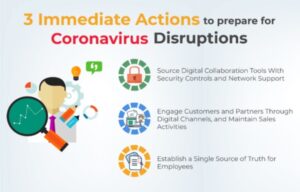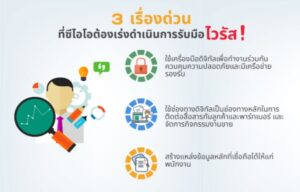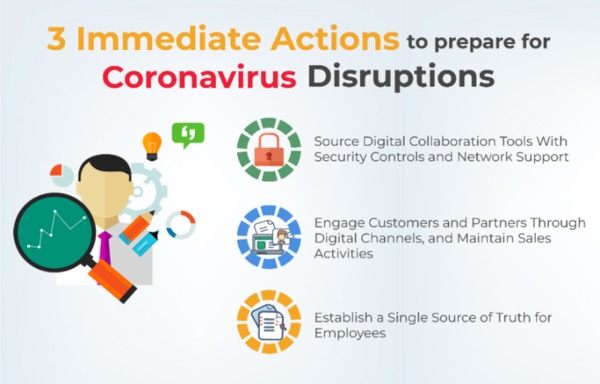
CIOs Must Have Large-Scale Business Plans and Preparations in Place
With the spread of the coronavirus (COVID-19), CIOs should focus on three short-term actions to increase their organizations’ resilience against disruptions and prepare for rebound and growth, according to Gartner, Inc. “With such a dynamic situation like COVID-19, it has the potential to be as disruptive, or more, to an organization’s continuity of operations as a cyber intrusion or natural disaster,” said Sandy Shen, senior research director at Gartner. “When traditional channels and operations are impacted by the outbreak, the value of digital channels, products and operations becomes immediately obvious. This is a wake-up call to organizations that focus on daily operational needs at the expense of investing in digital business and long-term resilience.”
Gartner recommends that CIOs focus on three short-term actions to provide support to customers and employees and ensure continuity of operations.
Source Digital Collaboration Tools With Security Controls and Network Support
Various quarantine measures and travel restrictions undertaken by organizations, cities and countries have caused uncertainties and disruptions as business operations are either suspended or run in limited capacity.
In organizations where remote working capabilities have not yet been established, CIOs need to work out interim solutions in the short term, including identifying use case requirements such as instant messaging for general communication, file sharing/meeting solutions, and access to enterprise applications such as enterprise resource planning (ERP) and customer relationship management (CRM), while reviewing all security arrangements to ensure secure access to applications and data.
Organizations also need to deal with staffing shortages to maintain basic operations. CIOs can work with business leaders to conduct workforce planning to assess risks and address staffing gaps, such as identifying mission-critical service areas. CIOs can see how digital technologies such as AI can be used to automate tasks, for example, candidate screening and customer service.
Engage Customers and Partners Through Digital Channels, and Maintain Sales Activities
Many organizations already engage customers over digital platforms, such as branded sites and apps, online marketplaces and social media. But offline face-to-face engagement still plays a big role. Workplace collaboration, video conferencing and livestreaming solutions can serve various customer engagement and selling scenarios. Organizations should also enable customers to use self-service via online, mobile, social, kiosk and interactive voice response (IVR) channels.
“The value of digital channels becomes obvious as market demand shrinks and as people rely more on online platforms for daily supplies.
Organizations can leverage digital channels, such as online marketplaces and social platforms, to compensate for some of the demand loss.” said Ms. Shen. “They can set up official pages/accounts and integrate commerce capabilities to enable online selling. They should also quickly adapt products to make them suited for selling through digital channels.”
Establish a Single Source of Truth for Employees
Confusing data from unverified sources — or the sheer lack of data — can lead to ill-informed decisions being made, escalating employee anxiety and making organizations underprepared for returning to normal operations. Such anxiety can be somewhat relieved if organizations can leverage data to support better decision making and communicate progress more efficiently to employees.
“Organizations can offer curated content, drawn from internal and external sources, to provide actionable guidance to employees. These sources include local governments, healthcare authorities and international organizations, such as the World Health Organization (WHO). HR and corporate communications leaders may be involved to vet the content and interpret the company’s policies,” said Ms. Shen. “Organizations should set up a site, app or hotline to share this information on a regular basis.
Employees can also use these platforms to notify the company about their health conditions and seek emergency support and care services.”
Gartner clients can learn more in the report “Coronavirus Outbreak: Short and Long-term Actions for CIOs.” Additional analysis on the actions CIOs and IT leaders should take to remain resilient during Coronavirus business disruptions will be available in the complimentary Gartner webinar “Coronavirus Outbreak: CIOs’ Short- and Long-term Actions,” taking place March 24 at 11AM ET. Learn more about how the IT, HR, supply chain, marketing, finance, legal and enterprise risk business units can prepare their organizations for a pandemic in the Gartner Special Report “Overcoming COVID-19 Through Pandemic Preparedness.”

ชี้ต้องมีแผนและการเตรียมตัวที่ครอบคลุมการดำเนินธุรกิจทั้งหมดและพร้อมนำมาใช้ทันที
จากสถานการณ์การแพร่ระบาดของเชื้อไวรัสโคโรน่า (COVID-19) การ์ทเนอร์แนะผู้บริหารด้านสารสนเทศหรือซีไอโอควรพุ่งความสำคัญกับแผนการดำเนินงานระยะสั้น 3 ประการเพื่อเพิ่มความยืดหยุ่นในการดำเนินธุรกิจรับมือกับผลกระทบต่าง ๆ ที่จะเกิดขึ้น พร้อมเตรียมความพร้อมสำหรับภาวะฟื้นตัวและสร้างการเติบโตอย่างต่อเนื่องให้กับองค์กร
“การแพร่ระบาดอย่างรวดเร็วและต่อเนื่องของเชื้อไวรัส COVID-19 มีแนวโน้มสร้างภาวะชะงักงันให้กับภาคธุรกิจหรือส่งผลกระทบมากขึ้นเสมือนกับเป็นการบุกรุกทางด้านไซเบอร์หรือเป็นภัยพิบัติทางธรรมชาติต่อการดำเนินงานองค์กรให้เกิดความต่อเนื่อง” นางสาวแซนดี้ เฉิน ผู้อำนวยการฝ่ายวิจัยอาวุโสของ การ์ทเนอร์กล่าวว่า “เมื่อช่องทางและการดำเนินธุรกิจในแบบเดิมได้รับผลกระทบจากการแพร่ระบาด จะส่งผลให้ช่องทางดิจิทัล ผลิตภัณฑ์ และการดำเนินงานมีคุณค่าขึ้นอย่างมีนัยสำคัญในทันที นี่คือการปลุกให้องค์กรต่าง ๆ ที่โฟกัสการดำเนินงานเป็นแบบวันต่อวันโดยเสียค่าใช้จ่ายลงทุนในธุรกิจดิจิทัลและเตรียมแผนความยืดหยุ่นการทำงานในระยะยาว”
การ์ทเนอร์แนะนำให้ซีไอโอมุ่งเน้นไปที่แผนระยะสั้น 3 ประการเพื่อสนับสนุนลูกค้า พนักงาน และสร้างความเชื่อมั่นว่าการปฏิบัติงานจะเป็นไปอย่างต่อเนื่อง
ใช้เครื่องมือดิจิทัลเพื่อทำงานร่วมกัน ควบคุมความปลอดภัยและมีเครือข่ายรองรับมาตรการกักกันต่าง ๆ และข้อจำกัดการเดินทางที่ดำเนินการโดยองค์กร เมืองและประเทศต่าง ๆ นั้นก่อให้เกิดความไม่แน่นอนและภาวะหยุดชะงักต่าง ๆ เนื่องจากถูกระงับหรือจำกัดในการดำเนินธุรกิจ
ในองค์กรที่ยังไม่มีความสามารถนำระบบทำงานแบบระยะไกลมาปรับใช้ได้นั้น ซีไอโอจำเป็นต้องหาโซลูชั่นชั่วคราวเพื่อแก้ไขสถานการณ์แบบระยะสั้น รวมถึงการระบุข้อกำหนดกรณีการใช้งาน เช่น การส่งข้อความทันทีเพื่อสื่อสารทั่วไป โซลูชั่นการแชร์ไฟล์ หรือ การประชุม และการเข้าถึงแอปพลิเคชันต่าง ๆ ขององค์กร เช่น ระบบวางแผนทรัพยากรองค์กร (ERP) และระบบจัดการลูกค้าสัมพันธ์ (CRM) ในขณะที่ต้องทบทวนการเตรียมการด้านความปลอดภัยทั้งหมดเพื่อให้แน่ใจว่าสามารถเข้าถึงแอปพลิเคชันและข้อมูลได้อย่างปลอดภัย
องค์กรยังต้องจัดการกับปัญหาการขาดแคลนพนักงานเพื่อประคับประคองการดำเนินงานขั้นพื้นฐาน ซีไอโอสามารถทำงานร่วมกับหัวหน้าทีมต่าง ๆ ดำเนินการวางแผนกำลังคนเพื่อประเมินความเสี่ยงและระบุช่องว่างการจัดบุคลากร เช่นการระบุพื้นที่บริการต่าง ๆ ที่มีความสำคัญต่อองค์กร โดยซีไอโอต้องสามารถทราบได้ว่าเทคโนโลยีดิจิทัล อย่าง AI สามารถนำมาใช้ในการทำงานอัตโนมัติได้อย่างไร ตัวอย่างเช่น ใช้ในการคัดกรองผู้สมัครและให้บริการลูกค้า ใช้ช่องทางดิจิทัลเป็นช่องทางหลักในการติดต่อสื่อสารกับลูกค้าและพันธมิตรไปจนถึงจัดการงานขาย
มีหลายองค์กรนำแพลตฟอร์มดิจิทัลมาใช้ติดต่อสื่อสารกับลูกค้า เช่น เว็บไซต์ และแอปพลิเคชันต่าง ๆ ของแบรนด์ตลาดซื้อ-ขายออนไลน์และโซเชียลมีเดีย แต่การติดต่อสื่อสารกับลูกค้าแบบออฟไลน์ยังคงมีบทบาทสำคัญ การทำงานร่วมกันในสถานที่ทำงาน โซลูชั่นการประชุมผ่านวิดีโอและไลฟ์สตรีมมิ่งสามารถตอบสนองความต้องการของลูกค้าและกิจกรรมการขายที่หลากหลาย องค์กรควรเปิดโอกาสให้ลูกค้าสามารถบริการตนเองผ่านช่องทางออนไลน์ อย่าง มือถือ โซเชียล ตู้ kiosk หรือใช้ระบบตอบสนองอัตโนมัติด้วยเสียง (IVR) ในช่องทางต่าง ๆ
“มูลค่าของช่องทางดิจิทัลจะเพิ่มขึ้นเมื่อความต้องการของตลาดลดลงและในขณะที่ผู้คนเชื่อมั่นในแพลตฟอร์มออนไลน์มากขึ้นในการหาซื้อสินค้าในชีวิตประจำวัน องค์กรสามารถใช้ประโยชน์จากช่องทางดิจิทัล เช่น ตลาดซื้อ-ขายออนไลน์และแพลตฟอร์มโซเชียลเพื่อชดเชยการหายไปของปริมาณความต้องการซื้อสินค้าบางส่วน” นางสาวเฉินกล่าวเพิ่มเติม “องค์กรสามารถสร้างเพจ หรือ บัญชีอย่างเป็นทางการและผสานรวมความสามารถทางการค้าเพื่อสร้างยอดขายผ่านออนไลน์ได้ โดยควรพัฒนาหรือปรับปรุงผลิตภัณฑ์อย่างรวดเร็วเพื่อให้เหมาะสมสำหรับการขายผ่านช่องทางดิจิทัล”
สร้างแหล่งข้อมูลหลักที่เชื่อถือได้ให้แก่พนักงาน
ข้อมูลที่สร้างความสับสนจากแหล่งที่มาที่ไม่ได้รับการรับรอง หรือการขาดข้อมูลสนับสนุนอันนำไปสู่การตัดสินใจที่ไม่เข้าใจบริบทของข้อมูลอย่างถ่องแท้นั้นสร้างความวิตกกังวลให้แก่พนักงานและการเตรียมแผนรับมือตอนกลับเข้าสู่โหมดการดำเนินงานในภาวะปกติขององค์กร ซึ่งความวิตกกังกลดังกล่าวบรรเทาลงได้หากองค์กรสามารถใช้ประโยชน์จากข้อมูลมาช่วยในการตัดสินใจได้ดีขึ้น และสื่อสารความคืบหน้าของสถานการณ์อย่างมีประสิทธิภาพต่อพนักงาน
“องค์กรสามารถนำเสนอเนื้อหาที่คัดสรรมาจากแหล่งที่มาภายในและภายนอกองค์กร เพื่อให้คำแนะนำแก่พนักงานนำไปปรับใช้ได้ โดยแหล่งข้อมูลเหล่านี้จะรวมไปถึงข้อมูลข่าวสารของรัฐบาลท้องถิ่น หน่วยงานและองค์กรด้านสาธารณสุขระหว่างประเทศ เช่น องค์การอนามัยโลก (WHO) โดยผู้นำฝ่ายทรัพยากรบุคคลและฝ่ายการสื่อสารองค์กรต้องมีส่วนร่วมในการตรวจสอบเนื้อหาและตีความนโยบายต่าง ๆ ของ บริษัท อย่างรอบคอบ” นางสาวเชนกล่าวเพิ่มเติมว่า “องค์กรควรจัดทำเว็บไซต์ แอปพลิเคชัน หรือ สายด่วนเพื่อแบ่งปันข้อมูลอย่างสม่ำเสมอ โดยพนักงานควรสามารถใช้แพลตฟอร์มเหล่านี้เพื่อแจ้งให้บริษัททราบเกี่ยวกับสถานะสุขภาพของพวกเขา แจ้งขอความช่วยเหลือและขอรับการดูแลพิเศษในกรณีเกิดเหตุฉุกเฉินได้”
ลูกค้าการ์ทเนอร์สามารถเรียนรู้รายละเอียดต่าง ๆ เพิ่มเติมได้ที่รายงาน “Coronavirus Outbreak: Short and Long-term Actions for CIOs.” พร้อมชมบทวิเคราะห์และการนำเสนอแนวทางรับมือเพิ่มเติมให้กับเหล่าซีไอโอและผู้นำด้านไอทีขององค์กรได้นำไปพิจารณาปรับใช้เพื่อนำพาองค์กรก้าวข้ามสถานการณ์ไวรัส COVID-19 ผ่าน webinar ของการ์ทเนอร์ เรื่อง “Coronavirus Outbreak: CIOs’ Short- and Long-term Actions,” ที่จะจัดขึ้นในวันที่ 24 มีนาคม เวลา 11AM ET (ตามเวลาท้องถิ่นในประเทศสหรัฐอเมริกา หรือราว 22:00 น. ตามเวลาในประเทศไทย)
เรียนรู้เพิ่มเติมเกี่ยวกับแนวทางการรับมือกับความเสี่ยงของผลกระทบจากเชื้อไวรัส COVID-19 ในแต่ละแผนกต่าง ๆ ขององค์กร อาทิ ฝ่ายเทคโนโลยีสารสนเทศ ฝ่ายทรัพยากรบุคคล ฝ่ายผลิต ฝ่ายการตลาด และฝ่ายการเงินได้ในรายงานล่าสุดของ Gartner “Overcoming COVID-19 Through Pandemic Preparedness.”


